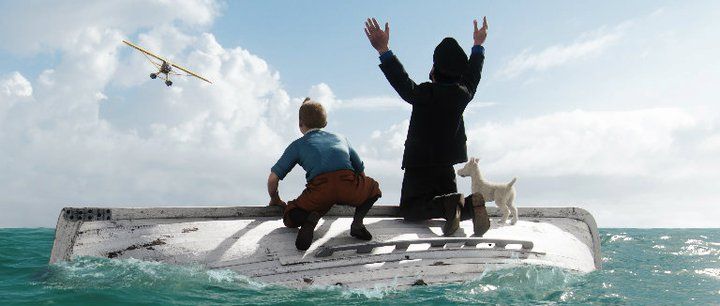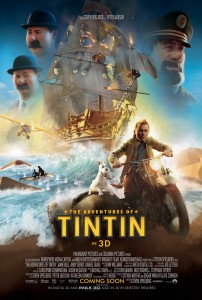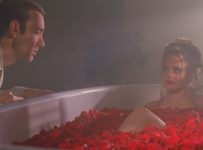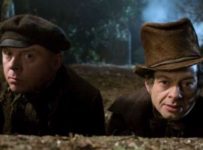[stextbox id=”grey” caption=”The Adventures of Tintin: The Secret of the Unicorn (2011)” float=”true” align=”right” width=”200″]
Director: Steven Spielberg
Runtime: 107 minutes
Starring: Jamie Bell, Andy Serkis, Daniel Craig, Simon Pegg, Nick Frost
Distributor: Paramount
Country: US/New Zealand
Rating: Highly Recommended (?)
[/stextbox]
The Adventures of Tintin first appeared in French in Le Petit Vingtième in 1929, where the industrious young reporter first went up against the Soviets. While his adventures became less politically charged over the years, the comics have been adapted into radio plays, two television series and of course, film. It may surprise some that there have been five films made over the last century, two of which were live action films in the 1960s. The advances in motion capture technology and animation have led to this latest version, and nobody except producer Peter Jackson (The Lord of the Rings Trilogy) and director Steven Spielberg (War Horse) could possibly do it justice.
The young journalist Tintin (Jamie Bell, Jane Eyre) and his faithful dog Snowy are out on the town when they discover a beautifully recreated model ship of The Unicorn, which he picks up for next to nothing. He is immediately hassled by an American and the oily Ivan Ivanovitch Sakharine (Daniel Craig, Cowboys and Aliens) who each seek to acquire the ship for large sums of money. Tintin declines, but soon finds himself in the midst of being shot at, abducted and whisked away to the far side of the globe by Sakharine, who seeks to find a secret hidden within the ships. Hooking up with the perpetually intoxicated Captain Haddock (Andy Serkis, The Rise of the Planet of the Apes), Tintin must uncover the secret of The Unicorn before Sakharine.
The Adventures of Tintin: The Secret of the Unicorn launches audiences straight into the action, picking up with what is effectively the eleventh book in the series. The past adventures of Tintin are alluded to in a flatly animated opening sequence, along with clippings that adorn Tintin’s walls. What will immediately strike people is just how beautiful and instant the immersion into this motion-captured world is, with an opening gag in which Tintin has his caricature done signalling clearly that this isn’t your daddy’s Tintin. The technology used to render the real actors into animated counterparts so realistically may seem redundant at first, with a lengthy introduction that gives us time to ponder the uncanny valley of facial expressions that we appear to have wandered into. Yet live action could never hope to recreate the action sequences that Spielberg is about to unleash on us, and in that fashion he sets about created the most Spielbergian film we have seen from the institution of filmmaker in several decades. Who knew we would just need to whisk the real world away from the maestro to give him back his mojo.
The film gets off to a slow start, and while Snowy serves as an excuse for Tintin’s constant monologues, one may be forgiven for thinking that ‘Tintin’ is Belgian for “exposition”. It is in the second act that the screenplay, by Steven Moffat (Doctor Who), Edgar Wright (Scott Pilgrim Vs. The World) and Joe Cornish (Attack the Block) kicks into high gear. With a subplot involving bumbling Inspectors Thomson (Nick Frost, Attack the Block) and Thompson (Simon Pegg, Mission: Impossible – Ghost Protocol), the script fumbles the earlier moments, searching for the right groove in which to establish Tintin in the 21st century. It turns out the right setting was Spielberg circa 1981, with the Raiders of the Lost Ark vibe strong once the action hits the Middle East. The extended sequence in which Tintin and co chase an eagle through the streets of Moroccan port of Bagghar are nothing short of phenomenal, showing the full extent to which motion capture humans and photo-realistic backgrounds can seamlessly blend to create something wholly impossible with any other combination of live action and special effects. Likewise, fantasy dream sequences, such a ship rising out sand dunes, and clever transition shots fully utilise the power of imagination. The technology may be new, but the stories hark back to a tradition as old as the medium.
The animation itself is gorgeous, with detail oozing out of every pristine frame. It will take at least two viewings (trust us) to start catching all of the details. Yet the secret to the success of the action is not that it achieves the impossible through animation, but that it is treated as though it is a live-action film. Spielberg’s regular cinematographer Janusz Kamiński has been brought in to lens the film, and the experience of almost three-dozen feature films makes the world of difference to the look of the picture.
The actors shine in their roles as more than simply digital puppeteers, with every facial expression and tick recreated on screen. Serkis as Haddock is clearly the most accomplished, having performed in this fashion throughout The Lord of the Rings, King Kong, The Planet of the Apes and the forthcoming The Hobbit. With his bulbous nose and unwieldy gait, Serkis avoids the uncanny valley look at almost emerges out the other side as too over the top. Craig, Frost and Pegg are all spot-on, and it is perhaps only Bell who fails to (motion) capture Tintin, being more Jamie Bell than the titular reporter. Yet this is a minor quibble in what is otherwise perfect animation.
The Adventures of Tintin: The Secret of the Unicorn is undoubtedly one of the best action films of the year, and certainly the most beautiful to look at. While some early pacing problems threaten to derail it slightly, the cracking pace it sets itself ensure that this is one that will need to be seen again and again. Setting itself up for the sequel, Red Rackham’s Treasure, the success of this film may ensure we have plenty of Tintin to come in the future. The stunning technology that brought this to us also means that the actors may age, but the characters will never die.
[stextbox id=”custom”]A wonderful reawakening of Tintin for a new generation, that tips its hat and remains faithful to the spirit of the original. A must-see this holiday season. [/stextbox]
The Adventures of Tintin: The Secret of the Unicorn is released on 21 December 2011 in the US and 26 December 2011 in Australia from Paramount.







My school library had these when I was a kid. I recall our year 10 english teacher sending our class out to get a book to read for the term and most of the class coming back with Tintin or Asterix.